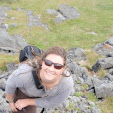If all goes according to plan, I will be staying in Chile until mid-December. I will spend about 6 weeks in the mountains at a reserve near La Parva trapping monster coruros (over 120 g. as opposed to 75 g. in Rinconada) and collecting environmental data. This will allow me to make a two-population comparison, strengthening my research. I will be able to make not only within population comparisons, but between population comparisons as well!
El Murado outside Cajón del Maipo
I have been so caught up with the research and preparation for the field I find myself exhausted every evening. It seems nearly impossible but almost three weeks ago I was riding up a funicular to the top of San Cristobal to visit the enormous Virgin Mary statue who sat upon said hill. After that, I somehow found myself in the Andes on the Fourth of July, staring up at an Andean condor in disbelief. And now today, 6 coruro captures later, I was staring at two lovely foxes crossing the valley about 200 m. before us with me hoping that they stay away from the traps and not pee on them again.
My project ideas have been mashed, molded and mashed a little more for good measure. Right now, we are working hard every day to collect all that we can about the coruros and the environment around them. We are taking time to get to know our little friends as well. Below is a picture of Machito. He was such a ham as he posed for the camera. Today we caught our first female. What a fiery and clever little thing she was! And how uncooperative! My gosh!
Look at this handsome devil!
That's all for now. More news soon to come. We are planning a trip to somewhere outside Chile, sometime in August. I must leave the country before my 90 days are up on my visitor's visa. It will be a surprise for both of us once I decide where to go. Also, a trip to Valdivia, in the south of Chile, is in the works. I am going to beg and plead my adviser to take me to Chiloé while I am there. There is such a uniqueness and abundance of life there that even Darwin himself would be in awe of.












